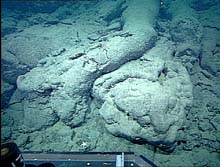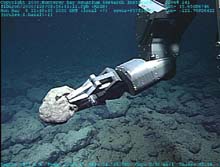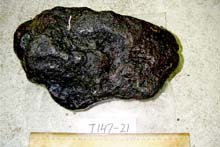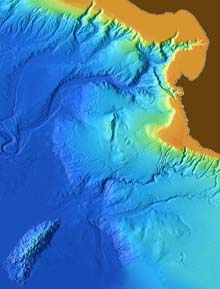These are typical pillow lavas. They form near the outer edges of lava flows, creating narrow "fingers" that crust over. When lava pressure builds up from behind, the tip of the finger breaks out, forming another rounded lobe, or "pillow," at the end. Here you can see how several sets of pillow lavas have flowed over each other. Beneath the pillow lavas, the flow is more blocky. Click image for larger view and image credit.
Geology of Davidson Seamount
David Clague
Senior Scientist
Monterey Bay Aquarium Research Institute
Davidson Seamount is one of a group of submarine volcanoes off the continental margin offshore central California, between Lat 37.5° and Lat 34.0°. Davidson Seamount — along with Guide, Pioneer, Gumdrop, and Rodriguez — differ morphologically from typical ocean island volcanoes.
All of the seamounts in this group are complex northeast-to-southwest trending structures, consisting of parallel ridges separated by sediment-filled troughs. The ridges are parallel to the fossil spreading-centers abandoned when the San Andreas fault system formed. On each of these seamounts, a series of knobs align along the ridges; however, craters like those commonly topping oceanic volcanoes are lacking. The lack of so-called "collapse craters" suggests that the lavas that built the seamounts were never stored in chambers within the volcanoes, as is common at other oceanic volcanoes.
The manipulator arm of the remotely operated vehicle Tiburon collects a piece of basaltic (volcanic) lava. The surface covered with blocky lava (in the background) is fairly typical of Davidson Seamount — more so than the pillow lavas (shown in the first photo). Click image for larger view and image credit.
The surfaces of the seamounts are built mainly of blocky lava flows, although we have seen some pillow lava on their deeper flanks. Near the summit, we find layered deposits of volcanic ash and pyroclastic materials. These volcaniclastic rocks indicate mildly explosive eruptions of gas-rich lava near the summit of the volcano.
Ar-Ar laser fusion ages (a dating technique) of mineral separates indicate that Davidson formed about 9- to 15-million years ago. This means it formed 5- to 12-million years after the underlying ocean crust.
The volcanic rocks found on Davidson Seamount are predominantly differentiated alkalic basalt, hawaiite, mugearite, and trachyte. These evolved lavas are highly viscous (thick and pasty) and form short, thick flows and steep-sided knobby structures at the vents. The high viscosity of these lavas also likely inhibited the loss of gas bubbles, thereby making the eruptions more explosive. The lavas traveled to the surface carrying up rare xenoliths (foreign rocks) of mantle materials as well as a range of coarsely crystallized fragments of lava, which slowly solidified at depth.
All the silt and slimy living stuff has been removed from this basalt (volcanic rock) sample from Davidson Seamount. This photo shows how basalts are typically fine-grained, massive, very dark rocks. In fact, researchers find it difficult to tell much about oceanic — even with a hand lens. That is why we use chemical analysis to determine which rocks are related to each other, and where they came from. Click image for larger view and image credit.
This image shows Davidson Seamount in relation to Monterey Bay and the California coast. As you can see, Davidson is far offshore, beyond the continental borderland area (the continental shelf and the continental rise), with its dramatic submarine canyons. In fact, its base is probably partially buried in deep-sea muds. Click image for larger view and image credit.
























